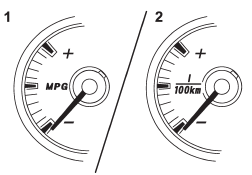Subaru Outback (BR): ECO gauge

1) U.S.-spec. models
2) Except U.S.-spec. models
The ECO gauge shows the difference between the average rate of fuel consumption and the current rate of fuel consumption. Using the average rate of fuel consumption since the trip meter was last reset, the indicator needle behaves as described in the following items.
U.S.-spec. models:
If the current rate of fuel consumption is lower than the average rate of fuel consumption, the indicator needle points to the “+” side. If the current rate of fuel consumption is higher than the average rate of fuel consumption, the indicator needle points to the “−” side. When the indicator needle is pointing to the “+” side, it indicates fuel-efficient driving.
Except U.S.-spec. models:
If the current rate of fuel consumption is lower than the average rate of fuel consumption, the indicator needle points to the “−” side. If the current rate of fuel consumption is higher than the average rate of fuel consumption, the indicator needle points to the “+” side. When the indicator needle is pointing to the “−” side, it indicates fuel-efficient driving.
NOTE
● The ECO gauge shows only an approximate indication.
● After resetting the trip meter, the average rate of fuel consumption is not shown until driving 0.6 mile (1 km). Until that time, the ECO gauge does not operate.

